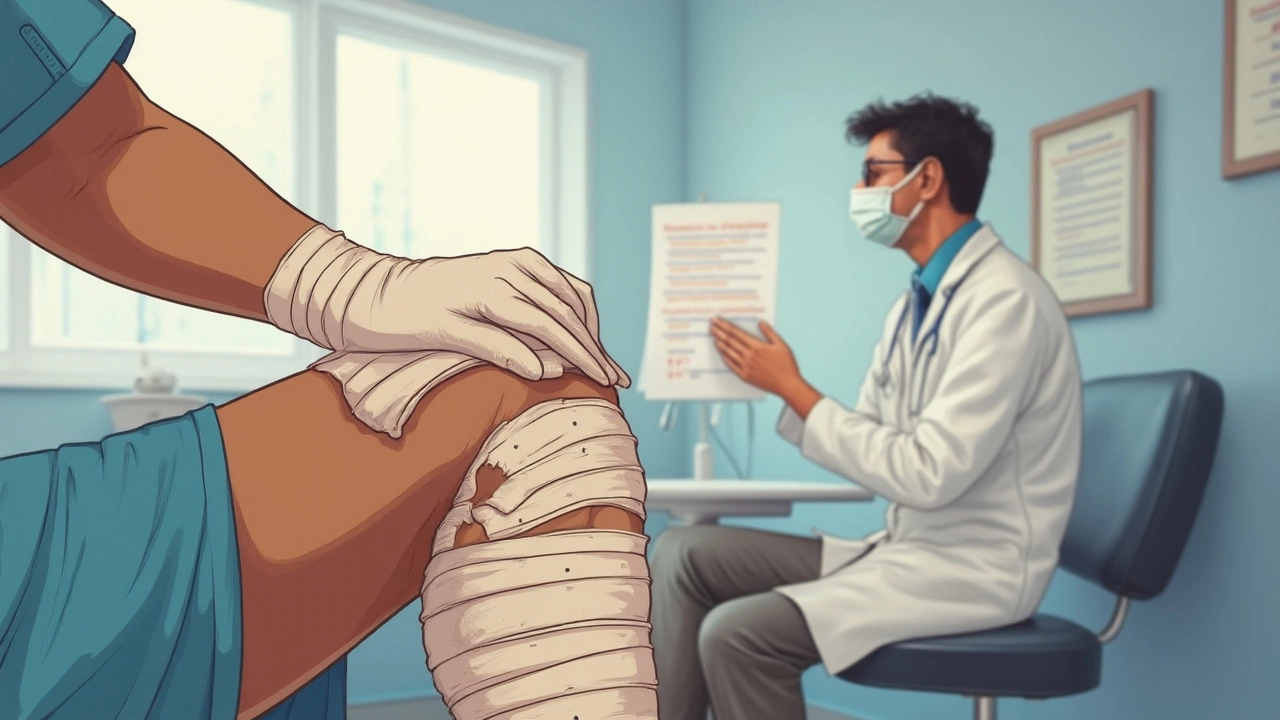
The urge to wash away sweat and hospital smell after knee surgery is real. But if someone told you not to set foot in the shower right away—trust them. It’s not about being dramatic. When you’ve had a knee replacement, your surgical wound is fresh and super vulnerable. A shower might seem harmless, but plain water can mess up healing much faster than you’d think.
Here’s the simple truth: dripping or spraying water over an unhealed wound lets bacteria sneak in. Your new knee is under the skin, but every drop counts. Most infection cases in the first month come from bacteria finding their way through the wound, especially if it got wet too soon. And infection after a knee replacement isn’t just a hassle—it can lead to months of rehab, more surgery, and a nightmare battle with antibiotics.
So, when the nurse says, "don’t shower yet," it’s not just to annoy you. It’s for your new knee’s safety and your peace of mind. Don’t worry, keeping clean without a shower isn’t as gross or tricky as it sounds, and I’ll break down what actually works (and what’s just nonsense from the internet) in the next sections.
- What Really Happens Right After Knee Surgery
- The Risks of Showering Too Soon
- Doctor-Approved Ways to Keep Clean
- How to Know When It’s Finally Safe
What Really Happens Right After Knee Surgery
Once you roll out of the operating room after a knee replacement, your body pushes into high gear to start healing. It’s not pretty—think swelling, redness, and that big bandage hugging your knee. Underneath, the surgical wound is basically a thin tunnel that’s struggling to close up and keep germs out.
The first couple of days are crucial. Your immune system is working overtime, and the hospital staff checks your wound’s color and drainage almost obsessively. Why? Because right after surgery, your wound isn’t a closed book yet. There’s usually a dressing that can't get wet because even a splash can let bacteria swim straight in.
Here’s something most people don’t realize: new research shows about 1 in 60 knee replacement patients gets a wound infection, most often because of early exposure to water or dirt. Numbers like these are why doctors are strict.
| Healing Stage | What’s Happening | How Long It Lasts |
|---|---|---|
| Fresh Wound | Incision is open and super sensitive to bacteria | 0-3 days |
| Early Healing | Edges start sticking together, but skin isn’t sealed | 3-10 days |
| Sealed Wound | Top layers sealed, catching most bacteria | 10+ days (if no issues) |
And don’t expect all wounds to heal at the same rate. Factors like diabetes, smoking, or being overweight can slow down your healing, making it even riskier if you get the wound wet too early. That’s why the surgeon always asks about your health history before giving the okay for a shower.
No matter how tempting it is to wash up, think of your knee as an open door for germs for at least the first week. That’s why waterproof dressings and sponge baths come into play—which you’ll get the full details on in a bit.
The Risks of Showering Too Soon
Jumping in the shower right after knee surgery can cause problems that aren’t obvious—until they really mess up your recovery. The biggest reason to hold off? Your wound just isn’t sealed yet. Water, even from a clean shower, carries germs. Once the incision is wet, those germs can wiggle down to your new knee, and that’s where the real issues start.
The main risk is infection. According to a recent review by the American Academy of Orthopaedic Surgeons, getting the wound wet too soon can make the risk of infection go up by as much as four times compared to keeping the area dry. And infection after knee replacement surgery is a big deal—not only does it hurt, but it can also mean extra surgeries, longer hospital stays, and expensive antibiotics. Here’s a quick look at the numbers:
| Complication | Risk if Wound Gets Wet | Risk if Wound Stays Dry |
|---|---|---|
| Infection | Up to 4% | About 1% |
| Delayed Healing | 6% | 2% |
| Scarring Issues | 8% | 2% |
It’s not just infection you have to worry about. Water can soften up the skin around the incision, making it easier for the wound to pop open. If that happens, healing takes longer and you might even see more scarring in the end.
Some people try to "waterproof" the area with plastic wraps or tape, but those rarely keep things dry enough. One small leak, and you’re at risk again. That’s why most surgeons are so strict about this rule—they’ve seen too many people try shortcuts and pay the price later.
Apart from infection and slow healing, there’s also a risk of slipping in the shower when you’re not steady on your feet. Crutches, wet tiles, and soap can turn your bathroom into a danger zone. It’s just not worth it for a few days of extra comfort.

Doctor-Approved Ways to Keep Clean
You can’t just ignore personal hygiene while your knee heals, but there are safe ways to stay fresh that don’t put your recovery at risk. Doctors and nurses have heard every hack in the book, and their advice is way more practical than you might think. Here’s what actually works while you wait for the green light to shower:
- Sponge baths are your go-to. Grab a clean washcloth or sponge, some gentle, unscented soap, and a bowl of warm water. Just make sure to avoid the area where your incision or bandage is. Focus on your underarms, neck, face, feet, and everywhere that tends to get sweaty or oily. Most hospitals recommend this method for the first week or two, depending on how your wound’s healing.
- Pre-moistened wipes (think baby wipes or those designed for sensitive skin) are a solid backup. Look for fragrance-free, alcohol-free versions so you don’t irritate your skin. These are quick and perfect for touch-ups on days you just don’t have the energy for a sponge bath.
- Dry shampoo can help manage oily hair. There’s no shame in using a shower cap for the rest—the aim is to keep moisture far away from your healing knee.
- If you really can’t stand it, talk to your doctor about waterproof dressings. Some are safe for brief showers, but they have to be applied the right way. Never try to DIY this with cling film or random bandages—it almost never works and can even make things worse.
It’s tempting to think a quick rinse won’t hurt, but studies show patients who kept their wounds dry for at least 7-10 days had infection rates lower than 1%. That number jumps in cases where the wound got wet in the first week.
| Method | When to Use | Safety Tips |
|---|---|---|
| Sponge Bath | Daily, until told otherwise | Keep incision and bandage dry |
| Pre-moistened Wipes | Quick clean-ups anytime | Pick unscented and alcohol-free |
| Dry Shampoo | As needed for hair | Avoid water near knee |
| Waterproof Dressing & Quick Shower | Only if doctor OKs | Follow all instructions closely |
It isn’t glamorous, but these basic cleaning routines help you avoid infections and get the best results from your knee replacement. Once the scar’s sealed and your doctor says it’s fine, that first real shower will feel like a prize.
How to Know When It’s Finally Safe
So, when can you actually get back in the shower without stressing out over wrecking your new knee? It’s not the same answer for everyone, but you can follow some real-world guidelines to avoid trouble and keep healing on track.
Most surgeons say it’s safe to start showering again once the incision is totally closed and dry—no oozing, no scabbing, no redness or swelling left. Usually, that’s about 10 to 14 days after knee replacement surgery, but it really depends on how your body heals.
Dr. Karen Sutton, an orthopedic surgeon at Yale, puts it this way:
“Don’t rush to get the incision wet. I always tell my patients that a dry wound is a happy wound. Wait until all stitches or staples are out, the wound looks sealed, and your doctor says it’s okay before hopping in a shower.”
How can you tell if it’s safe on your own? Keep an eye out for these:
- No drainage or blood spots on your bandage for at least 24 hours
- Skin at the incision is fully closed, with no gaps or soft spots
- No redness, swelling, or warmth around the wound
- Your surgeon (or nurse) gives you a clear thumbs-up
Here’s a quick look at when most folks get the green light:
| Type of Closure | Shower Safe After |
|---|---|
| Sutures (Stitches) | 10-14 days, or once removed |
| Staples | 10-14 days, or once removed |
| Surgical glue/steri-strips | About 7-10 days, when strips fall off and wound is sealed |
But remember, never soak in bathtubs, hot tubs, or pools until your doctor says go—those can delay healing or cause infection even if the wound looks okay. And even after your first shower, dry the area gently and skip scrubbing or using harsh soaps.
If you spot any unexpected redness, swelling, or see anything leaking from the wound after your first shower, call your doctor—don’t try to fix it yourself. Quick action can keep small issues from turning into big setbacks.

Write a comment